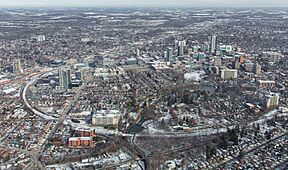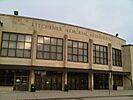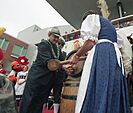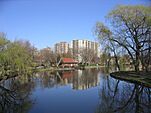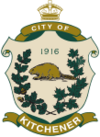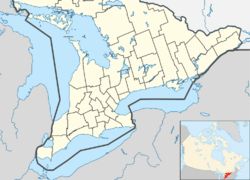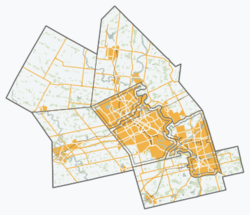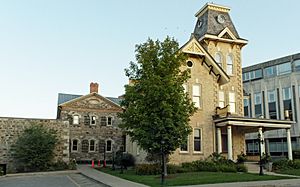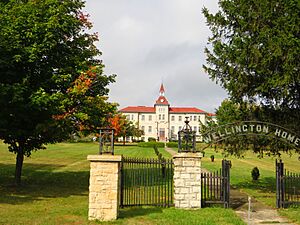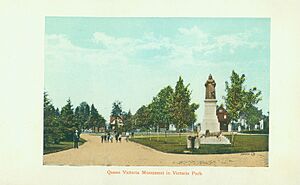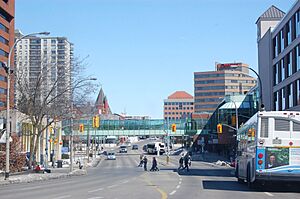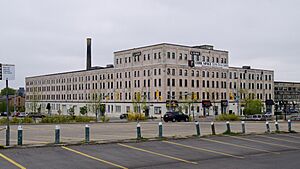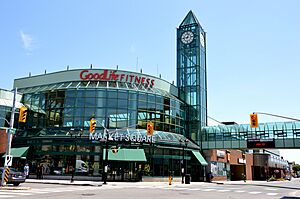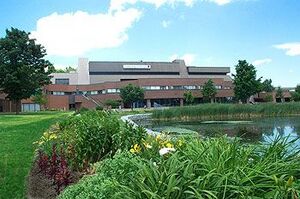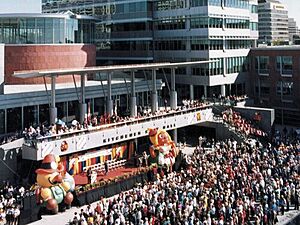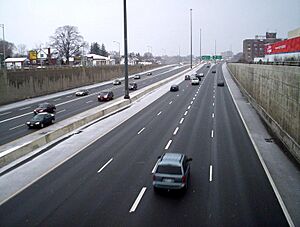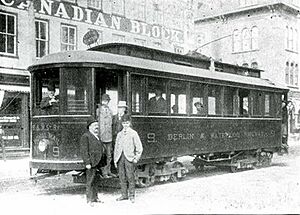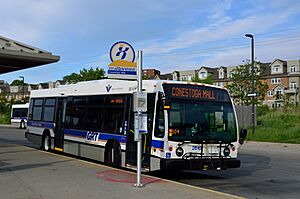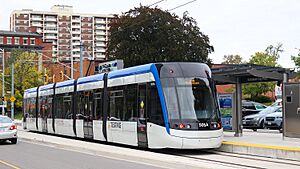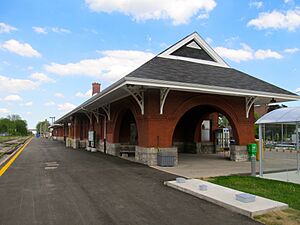Kitchener, Ontario facts for kids
Quick facts for kids
Kitchener
|
|||||
|---|---|---|---|---|---|
| City of Kitchener | |||||
|
From top, left to right: Downtown Kitchener, Benton and Frederick Streets, Kitchener Memorial Auditorium Complex, Oktoberfest, and Victoria Park
|
|||||
|
|||||
| Motto(s):
Ex industria prosperitas (Latin: Prosperity through industry)
|
|||||
| Country | Canada | ||||
| Province | Ontario | ||||
| Region | Waterloo | ||||
| Founded | 1807 | ||||
| Incorporated | 1833 | ||||
| Incorporated | 1912 (city) | ||||
| Area | |||||
| • City (lower-tier) | 136.81 km2 (52.82 sq mi) | ||||
| • Land | 136.81 km2 (52.82 sq mi) | ||||
| • Urban | 269.23 km2 (103.95 sq mi) | ||||
| • Metro | 1,091.16 km2 (421.30 sq mi) | ||||
| Population
(2021)
|
|||||
| • City (lower-tier) | 256,885 | ||||
| • Density | 1,877.68/km2 (4,863.16/sq mi) | ||||
| • Urban | 470,015 (10th) | ||||
| • Urban density | 1,745.8/km2 (4,522/sq mi) | ||||
| • Metro | 575,847 (10th) | ||||
| • Metro density | 480.1/km2 (1,243/sq mi) | ||||
| Demonym(s) | Kitchenerite | ||||
| Time zone | UTC−5 (EST) | ||||
| • Summer (DST) | UTC−4 (EDT) | ||||
| Forward sortation area |
N2A to N2H, N2M to N2R
|
||||
| Area codes | 519, 226, 548, and 382 | ||||
| GNBC Code | FEBWC | ||||
| GDP (Kitchener–Cambridge–Waterloo CMA) | CA$32.89 billion (2020) | ||||
| GDP per capita (Kitchener–Cambridge–Waterloo CMA) | CA$52,484 (2016) | ||||
| Website | www.kitchener.ca | ||||
Kitchener is a city in the Canadian province of Ontario. It is about 100 km (62 mi) west of Toronto. Kitchener is one of three cities that form the Regional Municipality of Waterloo. It is also the main administrative centre for the region.
Kitchener was once called Berlin. Its name was changed in 1916 after a public vote. The city covers an area of 136.86 km2 (52.84 sq mi). In 2021, its population was 256,885 people.
The Regional Municipality of Waterloo had 673,910 people by the end of 2023. This makes it the 10th largest city area in Canada. It is also the fourth largest in Ontario. Kitchener and Waterloo are known as "twin cities" and are often called "Kitchener–Waterloo" (K–W). However, they have their own separate city governments.
Contents
- History of Kitchener
- Kitchener's Economy
- Demographics
- Geography and Climate
- Education in Kitchener
- Culture in Kitchener
- Recreation in Kitchener
- Transportation in Kitchener
- Neighbourhoods
- Sports in Kitchener
- Other Sports Teams and Leagues
- Notable People from Kitchener
- Images for kids
- See also
History of Kitchener
Early Indigenous History
Long ago, Indigenous people lived in the area that is now Kitchener-Waterloo. After the last ice age, the land became open for people to hunt and live. Not many sites from the very early Paleo-Indian Period (13,000 BC to 1000 BC) have been found yet.
During the Archaic Period (8,000 BC to 800 BC), people were mostly nomadic hunters and gatherers. They started using more advanced tools made of stone and animal bone. Over two dozen ancient sites from this time have been found in the Waterloo Region. These include campsites and tool-making areas.
Archaeologists believe the Neutral people expanded into the Kitchener-Waterloo area around the 1300s. This was during the Woodland Period (900 BC to 1650 AD). Some ancient village sites from the 1500s have been found near Schneider and Strasburg Creeks. Artifacts found under the city are even older, from about a thousand years ago. The Iroquoian people who lived here grew crops like corn, beans, and squash.
In 2010, a 500-year-old First Nations village was found in the Strasburg Creek area. It is thought to be from the ancestors of the Neutral Nation. Tools made of bone and stone, and arrowheads were found. In 2020, another site at Fischer-Hallman Road showed artifacts from a Late Woodland Iroquois village from around 1300 to 1600. About 35,000 objects were found, including a 4,000-year-old arrowhead.
Today, more than 18 Late-Woodland Period village sites have been found in the Waterloo Region.
First European Settlers
German Company Tract
Kitchener is on part of the Haldimand Tract. This land was bought by the British from the Mississaugas in 1784. It was then given to the Six Nations for their help during the American Revolution. Between 1796 and 1798, the Six Nations sold 38,000 hectares of this land to Colonel Richard Beasley.
This land was far away, but it was very interesting to German Mennonite farming families from Pennsylvania. They wanted a place where they could practice their beliefs freely. The Mennonites eventually bought all of Beasley's unsold land. This created 160 farm areas.
After 1803, many pioneers from Pennsylvania, known as the Pennsylvania Dutch, bought land. This was a 60,000-acre section from the German Company. This company was started by Mennonites from Lancaster County, Pennsylvania. The land included most of Block 2 of the old Grand River Indian lands. Many of the first farms were at least 400 acres. The German Company bought the land from Richard Beasley. He had financial problems after buying it in 1796 from Joseph Brant, who represented the Six Nations. The payment for Beasley arrived from Pennsylvania in barrels, carried in a wagon with armed guards.

The first settlers in the area of what became Doon (now part of Kitchener) arrived in 1800. They were two Mennonite brothers-in-law from Franklin County, Pennsylvania: Joseph Schoerg (later Sherk) and Samuel Betzner Jr. Their homes, built by the next generation around 1830, still stand on Pioneer Tower Road in Kitchener. They are considered historically important.

By 1800, the first buildings in Berlin were built. Over the next ten years, several families moved to the area, then called the Sandhills. One Mennonite family, the Schneiders, arrived in 1807. Their restored 1816 home is the oldest building in the city. It is now a National Historic Site and museum in Kitchener. Other families who settled here include the Bechtels, Ebys, Erbs, Webers, Cressmans, and Brubachers. In 1816, the government named the settlement the Township of Waterloo.
Much of the land, with its hills and swamps, was turned into farmland and roads. Wild pigeons, once very common, were driven away. Apple trees were brought by John Eby in the 1830s. Several mills were built, including Joseph Schneider's sawmill in 1816. Schneider built Berlin's first road from his home to the corner of King Street and Queen Street. Settlers raised money to extend the road further.
From Ebytown to Berlin (1806–1852)
Benjamin Eby, who later became known as the founder of Berlin, arrived from Pennsylvania in 1806. He bought a large area of land that would become the village of Berlin, named in 1833. The settlement was first called Ebytown. Benjamin Eby also helped the Mennonite church grow in Waterloo County. By 1811, he built a log meeting house that was first used as a school.
Benjamin Eby encouraged manufacturers and craftspeople to move to Ebytown. Joseph Schneider built a house in 1820. A small settlement grew around "Schneider's Road," which became the heart of Berlin. The village centre was set up in 1830 by Phineas Varnum, who opened a blacksmith shop. A tavern and a store also opened.
Friedrich Gaukel bought the Varnum tavern site in the early 1830s. In November 1833, he bought land along the main street (King Street) from Joseph Schneider. These sales documents are the first to use the name Berlin for the community.
The Smith's Canadian Gazetteer of 1846 described Berlin as having about 400 people, mostly Germans. It had a newspaper called "the German Canadian" and a Lutheran church. The Township of Waterloo had mostly Pennsylvanian Mennonites and German immigrants. Many did not speak English at the time. In 1841, the township had 4,424 people.
The first cemetery in the city was near Pioneer Tower in Doon, with a burial recorded in 1806. The cemetery at First Mennonite church has graves of important citizens like Bishop Benjamin Eby.
Becoming a County Seat (1853)
Waterloo became a separate county in 1853, with Berlin as its main town. There was a debate between Galt and Berlin about where the county seat should be. One requirement was to build a courthouse and jail. When Joseph Gaukel donated land for these buildings, Berlin was chosen. The courthouse and jail were built quickly. The first county council meeting was held there on January 24, 1853.
The Waterloo County Gaol (jail) is the oldest government building in the Region of Waterloo. The Governor's House, where the jailer lived, was added in 1878. Both buildings have been restored and are now recognized as historic places.
Growth of "Busy Berlin" (Late 19th Century)
Arrival of Railways
The Grand Trunk Railway extended its line through Berlin in July 1856. This greatly helped the community grow and become more industrial. After 1850, immigrants from Germany, mostly Lutheran and Catholic, became common in the city. They brought new German traditions, like gymnastics clubs and band music. By 1869, Berlin had a population of 3,000.
In the late 1880s, a street railway was built to connect Berlin to Waterloo in 1888. It became electric in 1895, making it the first electric railway in Berlin. Later, the Preston and Berlin Street Railway was built in 1904, connecting Berlin to Preston (now part of Cambridge).
House of Industry and Refuge
In 1869, the county built a large building called the House of Industry and Refuge. It had a farm and helped about 3,200 people before closing in 1951. This building was on Frederick St. in Kitchener. It was meant to help people who were struggling, before there were many social support programs. People who lived there worked on the farm or in the house.
Research shows that the "inmates" included people with disabilities, women, and children. Some were single mothers who had been servants. Since there were no social services, they were sent to the House. The House also gave food, clothing, and train tickets to help people reach family. There were also cemeteries nearby for those who died there.
City Institutions
On June 9, 1912, Berlin officially became a city. The City Hall was in a two-story building at King and Frederick Streets, built in 1869. This building was also used as a library, theatre, post office, market, and jail. It was torn down in 1924 and replaced by a new building. The clock tower from the old City Hall was later moved to Victoria Park in 1995. The current Kitchener City Hall on King Street was built in 1993.
Kitchener was often one of the first cities in Ontario to adopt new public services. These included library boards and planning boards. This movement began in the 1890s with the creation of a parks board, which led to Victoria Park. In 1899, a water commission was created after a big fire and the need for a steady water supply for industries. The city's gas and electric services were also taken over by the city in 1903.
In 1904, Berlin created the first sewage commission in Canada to deal with its growing sewage problem. The Berlin and Waterloo Street Railway was also taken over by the city. Kitchener was the first city in Ontario to get hydroelectric power from Niagara Falls on October 11, 1910.
Berlin to Kitchener Name Change
Berlin had a strong German character because many German-speaking immigrants settled there. These immigrants brought skills, tools, and different customs. When First World War started, the British Empire (and Canada) fought against the German Empire. This led to suspicion and unfair treatment of people with German backgrounds.
In Berlin, anti-German feelings grew during the war. The statue of Kaiser Wilhelm I in Victoria Park was damaged in 1914. Despite showing loyalty to Canada, the city's German community faced attacks from soldiers. In a series of votes in 1916, Berlin was renamed Kitchener. This was after Herbert Kitchener, 1st Earl Kitchener, a British military leader. The first vote to change the name passed by a small amount. Some historians believe soldiers influenced the vote. In a second vote, "Kitchener" was chosen as the new name. In September, the city of 19,000 people was renamed.
German Culture in Kitchener
Kitchener has the strongest German heritage in the Waterloo Region. This is because many German-speaking immigrants settled here.
While many came from Pennsylvania, Germans from Europe also started arriving in 1819. These immigrants brought their language, religion, and traditions. The German community became leaders in industry and politics. They created a unique German-Canadian society. They also started German public schools and churches.
Both groups of German speakers, from Pennsylvania and Europe, spoke German dialects. They could understand each other easily. Some estimates say about 50,000 Germans from Europe settled in Waterloo County between the 1830s and 1850s. Unlike the Mennonites, most of these Germans were Catholic or Lutheran.
In 1862, German-speaking groups held a "Singer Festival" (Sängerfest) in Berlin. It attracted about 10,000 people. Later, in 1873, Germans in Berlin started a new event called Friedensfest. This celebrated a Prussian victory in a war. This annual celebration continued until World War I. In 1897, they put up a large monument with a bronze statue of Kaiser Wilhelm I in Victoria Park. This monument was destroyed by townspeople after World War I began. A statue of Queen Victoria was put in the park in 1911.
By 1871, Berlin, Ontario, was a bilingual town. German was the main language spoken. Many visitors noted that speaking German was necessary in Berlin.
Immigration from Germany slowed by 1880. Most of the local German population were now born in Canada. They were proud of their German roots but also considered themselves loyal to the British. The 1911 Census showed that about 70% of Berlin's 15,196 residents were of German background. But only 8.3% were born in Germany.
At the start of World War I in 1914, Berlin and Waterloo County were still seen as mostly German. This had a big impact on local citizens during the war. As anti-German feelings grew, many churches stopped holding services in German.
The governor general of Canada, the Duke of Connaught, visited Berlin in May 1914. He spoke about the importance of Canadians of German ethnicity in Canada. He said he knew the good qualities of the "great Teutonic Race."
In 1897, a large bronze statue of Kaiser Wilhelm I was put in Victoria Park, Kitchener. It honoured the German-Canadian population. In August 1914, at the start of World War I, vandals removed it and threw it into the lake. The statue was found and moved to a club. But it was stolen again in 1916 by a crowd, mostly soldiers. It has never been seen since. Some say the soldiers melted it down. In 1996, a new monument with a plaque was put up to tell the story of the original statue.
The Waterloo Pioneer Memorial Tower was built in 1926. It remembers the Pennsylvania German settlers of the Grand River area. The Kitchener–Waterloo Oktoberfest celebrates the region's German heritage. It includes beer halls and German entertainment. It is the second largest Oktoberfest in the world. It attracts about 700,000 people. In 2016, about 150,000 people watched the Oktoberfest parade.
Suburban Growth (20th Century)
After the wars, many new neighbourhoods were built around the city. One example was the Westmount neighbourhood. It was designed like a wealthy suburb in Montreal. It was built on the hills north of the Schneider farm. Kitchener's Westmount got some street names from the Montreal suburb.
This development was led by Talmon Henry Rieder, a local rubber factory owner. He was inspired by the "City Beautiful movement." This movement focused on building grand city buildings and making cities more beautiful. Rieder called Westmount the "Development Beautiful."
This growth showed a desire to move away from busy industrial cities. People wanted cleaner air and more space. Cars made it easier to live further from work. Large, cheap plots of land were available. There was also a desire to create exclusive neighbourhoods without factories or shops. This was an early form of modern zoning.
The growth of rubber factories and cars helped these suburbs grow. Lands from the rural Waterloo Township were added to the city. This gave the suburbs access to city services. Westmount's planners made the streets winding, unlike the usual city grid. This made the area feel more like a park.
Kitchener's Economy
Kitchener's economy used to be mostly about manufacturing. You can still see industrial items in public places, celebrating this history. While manufacturing is less important now, in 2012, about 20% of workers were still in this sector.
The city has four business parks: Bridgeport, Grand River West, Huron, and Lancaster. The Huron Business Park has many different industries. Some well-known companies based in Kitchener include Waterloo Brewing Company, D2L, Vidyard, and ApplyBoard.
Kitchener's economy has become more diverse. It now includes growing areas like digital media and health sciences.
Since 2004, Kitchener has worked to improve its downtown area. This included a lot of investment and a plan called the Downtown Kitchener Action Plan.
The historic farmers’ market was reopened in 2004. The Kitchener Market is one of the oldest markets in Canada that has been open continuously. It sells local products, international foods, and crafts.
In 2009, the city started to rebuild and improve King Street in downtown Kitchener. They added new lights, wider sidewalks, and lower curbs to make it better for people walking. Movable posts were installed to allow for events and festivals. In 2010, the redesigned King Street won an award for its flexible design. In 2009, Tree Canada called King Street a "green street." It has new trees, bike racks, and special garden beds that clean stormwater. The street was rebuilt using recycled materials.
In 2006, construction began for the University of Waterloo School of Pharmacy and a downtown health sciences campus. It opened in 2009. This building is on King Street. McMaster University later opened a campus for its medical school next to it. This Health Sciences Campus has helped Kitchener's health science industry grow.
In 2007, a company bought the old Lang Tannery building for $10 million. With city support, they turned it into offices for businesses. The Tannery has become a centre for digital media companies. Desire2Learn, an e-learning company, expanded there. In 2011, Communitech moved into the Tannery. Communitech helps many high-tech companies in areas like information technology and advanced manufacturing. Also in 2011, Google Inc. became a tenant in the Tannery. Their Kitchener office is a big centre for developing Google's Gmail app.
The Province of Ontario built a new courthouse in downtown Kitchener. It was expected to create new jobs. Construction began in 2010.
Many old factories in the downtown area have been turned into modern apartments. In 2010, a big redevelopment project called ‘City Centre’ began downtown. It includes apartments, shops, parking, a gallery, and a hotel. The old Arrow shirt factory became a luxury apartment building.
By late 2017, the downtown area was booming. New developments worth $1.2 billion were expected. This would add 1,000 apartments and 1,800 condo units. The city said these would be tall residential buildings with shops on the ground floor. Since the Ion rapid transit (light rail) system was approved in 2009, there has been $2.4 billion in building permits along its route.
Demographics
| Historical population | ||
|---|---|---|
| Year | Pop. | ±% |
| 1871 | 3,473 | — |
| 1881 | 4,054 | +16.7% |
| 1891 | 7,245 | +78.7% |
| 1901 | 9,747 | +34.5% |
| 1911 | 15,196 | +55.9% |
| 1921 | 21,763 | +43.2% |
| 1931 | 30,793 | +41.5% |
| 1941 | 35,657 | +15.8% |
| 1951 | 44,867 | +25.8% |
| 1956 | 60,916 | +35.8% |
| 1961 | 74,485 | +22.3% |
| 1966 | 94,446 | +26.8% |
| 1971 | 111,805 | +18.4% |
| 1976 | 131,870 | +17.9% |
| 1981 | 139,734 | +6.0% |
| 1986 | 150,604 | +7.8% |
| 1991 | 168,282 | +11.7% |
| 2001 | 190,399 | +13.1% |
| 2006 | 204,688 | +7.5% |
| 2011 | 219,153 | +7.1% |
| 2016 | 233,222 | +6.4% |
| 2021 | 256,855 | +10.1% |
| Ethnic origin | Population | Percent |
|---|---|---|
| German | 51,050 | 17.7 |
| English | 48,350 | 15.9 |
| Irish | 37,630 | 13.7 |
| Scottish | 37,190 | 13 |
| Canadian | 54,490 | 11.5 |
| French | 20,790 | 6.1 |
| East Indian | 8,385 | 5.6 |
| Polish | 12,595 | 4.5 |
| Dutch | 9,815 | 3.7 |
| British | 8,805 | 3.5 |
| Italian | 7,620 | 3 |
| Portuguese | 6,225 | 2.4 |
| Chinese | 5,630 | 2.2 |
| Ukrainian | 5,540 | 2.2 |
| Source: StatCan (includes multiple responses) | ||
In the 2021 Canadian census, Kitchener had a population of 256,885 people. This was a 10.2% increase from its 2016 population of 233,222. The city has a land area of 136.81 km2 (52.82 sq mi). This means it had a population density of 1,877.7 people per square kilometre in 2021.
The larger Kitchener - Cambridge - Waterloo area had a population of 575,847 in the 2021 census. This was a 10% increase from 2016.
Ethnic Backgrounds
According to the 2021 Census, Kitchener's population is about 66.4% White. About 31.7% are from visible minority groups. And 1.9% are Aboriginal.
The largest visible minority groups include:
- 9.9% South Asian
- 6.9% Black
- 3.1% Latin American
- 3.7% Southeast Asian
- 1.8% Chinese
- 2.4% Arab
- 1.3% West Asian
- 1.1% Filipino
The most common ethnic backgrounds in Kitchener are German (17.7%), English (15.9%), Irish (13.7%), Scottish (13%), and Canadian (11.5%).
Religions in Kitchener
According to the 2021 census, religious groups in Kitchener included:
| Religion | Population | Percent |
|---|---|---|
| Christianity | 131,390 | 51.7 |
| Irreligion | 81,475 | 32.1 |
| Islam | 19,140 | 7.5 |
| Hinduism | 9,610 | 3.8 |
| Sikhism | 6,520 | 2.6 |
| Buddhism | 3,015 | 1.2 |
| Judaism | 525 | 0.2 |
| Indigenous Spirituality | 70 | <0.1 |
| Other | 2400 | 0.9 |
In 2021, 51.7% of people in Kitchener identified as Christian. The largest Christian group was Catholics (22.3%). Other groups include Orthodox (4.3%), Lutherans (3%), and Anglican (2.4%).
Other religions include Muslim (7.5%), Hindu (3.8%), and Sikh (2.6%). About 32.1% of the population said they had no religion.
Geography and Climate
Kitchener's Geography
Kitchener is in Southwestern Ontario, in the Saint Lawrence Lowlands. This area has wet soils and forests with trees that lose their leaves. It is in the Grand River Valley, generally above 300 m (980 ft) in height.
Kitchener is the largest city in the Grand River watershed. Just west of the city is Baden Hill, which is the highest point for many miles. Another important natural feature is the Waterloo Moraine. This winding ridge holds a lot of underground water, which is where the city gets most of its drinking water. The city's first name, Sandhills, described the higher parts of this moraine.
Kitchener's Climate
Kitchener has a humid continental climate. This means it has big seasonal changes. Summers are usually warm and humid, and winters are cold. Winter weather generally lasts from mid-December to mid-March. Summer temperatures usually occur from mid-May to late September.
In March 2012, Kitchener had a heat wave. From March 16 to 22, temperatures were very high, setting 7 new records. March 22 had the highest temperature ever recorded for March in this area, at 26.5 °C (79.7 °F).
Temperatures can go above 30 °C (86 °F) in summer and below −20 °C (−4 °F) in winter. But long periods of extreme temperatures are rare. Kitchener has about 147 frost-free days a year. This is less than cities closer to the Great Lakes because Kitchener is further inland and higher up. Snowfall averages 160 cm (63 in) per year.
The highest temperature ever recorded in Kitchener was 38.3 °C (100.9 °F) on August 6 and 7, 1918, and again on July 27, 1941. The coldest temperature ever recorded was −34.1 °C (−29.4 °F) on February 16, 2015.
Education in Kitchener
Kitchener has several public high schools. Kitchener–Waterloo Collegiate and Vocational School, founded in 1855, is the oldest. It is on King Street, near the border with Waterloo. In the 1950s and 1960s, new high schools were built. These include Eastwood Collegiate Institute (1956), Forest Heights C.I. (1964), Grand River C.I. (1967), and Cameron Heights C.I. (1967). In 2006, Huron Heights Secondary School opened.
The oldest Catholic high school is St. Mary's High School. It opened in 1907 for girls only. In 1990, it became co-ed after St. Jerome's High School closed. That same year, Resurrection Catholic Secondary School opened. In 2002, St. Mary's moved to a new location. The old St. Jerome's building now houses a part of Wilfrid Laurier University. The old St. Mary's building is now the head office for the Waterloo Catholic District School Board.
The Doon neighbourhood is home to the main campus of Conestoga College. This is one of the top non-university schools in the province. For nine years, Conestoga has been ranked highest among Ontario colleges for graduate employment and student satisfaction. It is one of only seven polytechnical institutes in Canada.
The University of Waterloo opened a School of Pharmacy downtown. The City of Kitchener contributed $30 million to help set it up. Construction began in 2006, and the pharmacy program started in January 2008. The school is expected to graduate about 120 pharmacists each year. It will also be home to the Centre for Family Medicine, where new family doctors will be trained.
The University of Waterloo's Downtown Kitchener Health Sciences Campus also has a campus for McMaster University's School of Medicine. The Michael G. DeGroote School of Medicine accepts 28 students each year. Students do their training at hospitals in the Waterloo-Wellington Region.
Emmanuel Bible College is also located in Kitchener.
Culture in Kitchener
Kitchener has many cultural events. These include CAFKA, The Open Ears Festival, IMPACT theatre festival, the Multicultural Festival, the Kitchener Blues Festival, and KidsPark. Many of these events are free.
Kitchener also has places like Homer Watson House & Gallery, Kitchener–Waterloo Art Gallery, THEMUSEUM, and Centre In The Square. There are also two local museums: the Waterloo Region Children Museum and the Doon Heritage Village.
You can hear live music by popular artists at Centre In The Square and The Aud. The Kitchener Public Library is also an important community place. Kitchener is home to an independent music label, Busted Flat Records, which features local musicians.
Kitchener–Waterloo Oktoberfest
Kitchener–Waterloo's Oktoberfest is a nine-day event that started in 1969. It is based on the original German Oktoberfest. It is called Canada's Greatest Bavarian Festival. It happens every October, starting the Friday before Canadian Thanksgiving. It is the largest Bavarian festival outside of Germany.
While it is known for its beer celebrations, there are also many family and cultural events. The most famous is the Oktoberfest Thanksgiving Day Parade. It is the only major parade on Canadian Thanksgiving and is shown on TV across the country. Another symbol of the festival is Miss Oktoberfest. This person is chosen to represent the festival.
The festival attracts about 700,000 people. In 2016, about 150,000 people watched the Oktoberfest parade.
Kitchener Blues Festival
The Kitchener Blues Festival is a four-day festival in downtown Kitchener. It is dedicated to blues music and is held every August. The festival has grown to four stages and two workshop stages. It features over 90 performances. It started as a one-day event with 3,000 people and now has over 150,000 attendees. In 2014, the festival celebrated its 14th year.
Kitchener–Waterloo Multicultural Festival
This is a two-day event in Victoria Park, usually held on the first weekend of summer. It is run by the Kitchener-Waterloo Multicultural Centre. The festival features foods, dance, and music from around the world. Vendors also sell crafts and artifacts. This festival has been running for over 40 years. More than 50,000 people attend every year.
KOI Music Festival
KOI Music Festival is a three-day festival held every September in downtown Kitchener. It started in 2010. The festival features over 100 rock bands each year, focusing on local, independent musicians.
Kultrun World Music Festival
Kultrún is an annual festival of world music, food, culture, and art. It takes place in Victoria Park every July. Music from various cultures is performed on two stages. The park is filled with vendors selling goods and many food stands with different ethnic foods.
LGBT Culture
The Kitchener-Waterloo region is home to tri-Pride and the Rainbow Reels Queer and Trans Film Festival. Unlike most LGBT pride events, tri-Pride does not have a parade. Instead, it focuses on an afternoon music festival on the final weekend.
Recreation in Kitchener
The Kitchener–Waterloo Symphony used to be in Kitchener. It performed over 222 concerts each year for more than 90,000 people. It was the largest employer of artists in the Waterloo Region.
Kitchener's oldest outdoor park is Victoria Park, in the heart of downtown Kitchener. Many events and festivals are held here.
A bronze statue of Queen Victoria is in Victoria Park, along with a cannon. The statue was revealed in May 1911, on Victoria Day.
Rockway Gardens are next to the Rockway golf course. They are a popular place for wedding photos in the summer.
Kitchener has a large system of community trails. These trails are hundreds of kilometres long. Many trails are along the Grand River. However, the city does not always provide enough money to maintain all the trails and natural areas.
In 2011, a bike park was built at the new McLennan Park in the south end of the city. It was praised as one of the best city-run bike parks in Southern Ontario. The bike park has sections for different types of biking, like four-cross (4X) and jump park. McLennan Park also has a play area, a splash pad, basketball courts, and a dog area.
Chicopee Ski Club is also located within the city.
Transportation in Kitchener
Highways and Expressways

Kitchener planned its transportation network well in the 1960s. The province built the Conestoga Parkway. This road goes across the south side of the city and then north along the Grand River.
The Conestoga Parkway includes provincial highways 7, 8, and 85. King Street becomes Highway 8 where it meets the Parkway. This leads to Highway 401.
There are two exits to Highway 401 on Kitchener's southern border. One is where Highway 8 joins Highway 401. The other is on the west side with Homer Watson Boulevard.
A new exit on Highway 401 at Trussler Road has been suggested to reduce traffic. This would help the fast-growing west side of Kitchener. However, the Ontario Ministry of Transportation does not plan to build it yet.
City Streets
Unlike most cities in southern Ontario, Kitchener's streets do not follow a strict grid pattern. They are laid out in a more complex radial pattern, similar to European cities. This is because the German settlers arrived before government surveyors. They divided their land and created roads based on what they knew from Switzerland and southern Germany.
This means major streets cut diagonally across smaller streets. They often meet at intersections with many points. In 2004, roundabouts were introduced in the Region of Waterloo. These help traffic flow better and reduce pollution from idling cars. The first two were installed in Kitchener in 2006.
Public Transport
Early Public Transport
The first public transport in Kitchener was a horse-drawn streetcar service on King Street. This was the Berlin and Waterloo Street Railway, which started in 1888. It became electric in 1895. The Preston and Berlin Street Railway connected Kitchener to Preston (now part of Cambridge) starting in 1904.
In 1906, the Berlin and Waterloo Street Railway was taken over by the city. It was later renamed the Kitchener and Waterloo Street Railway. In 1947, the streetcar system was replaced with trolleybuses. The streetcar tracks were removed in the 1950s. In 1973, local bus services became Kitchener Transit. Soon after, trolleybus service stopped, and the system used only diesel buses.
Grand River Transit
In 2000, Kitchener Transit merged with Cambridge Transit. It became Grand River Transit (GRT), managed by the Region of Waterloo. GRT now serves Kitchener, Waterloo, and Cambridge as one regional transit system. In 2003, GRT received money to fund its Central Transit Corridor Express plan. This led to the iXpress express bus service in 2005.
As of 2021, there are 54 GRT bus routes. 48 are local, and 6 are part of the iXpress system. Many GRT routes connect Kitchener to Waterloo and Cambridge.
Light Rail
In June 2011, the Waterloo Region council approved a plan for a light rail transit (LRT) system. This system runs between Conestoga Mall in north Waterloo and Fairview Park Mall in south Kitchener. Buses connect to Cambridge. The plan is to extend the light rail line to Cambridge later.
Construction of the light rail system began in August 2014. Service was expected to start in 2017 but was delayed. The service finally opened to the public on June 21, 2019.
As of 2021, Ion light rail serves only Kitchener and Waterloo. From downtown Kitchener, you can take a train as far north as Conestoga station in Waterloo and as far south as Fairway station in Kitchener. To reach Cambridge, you need to transfer to a bus.
Intercity Transit
Via Rail train service is available at Kitchener station. Via Rail trains go east to Toronto's Union Station and west to London and Sarnia.
Kitchener also has GO Transit buses and trains. GO Transit bus service to Kitchener started in 2009. GO train service was extended to Kitchener in 2011. GO train service goes east to Toronto's Union Station.
A new bus service by FlixBus started on April 9, 2022. It links Kitchener and Toronto more directly.
Railways
Kitchener's main railway line is the CN/GO Guelph Subdivision. It runs east-west through northern downtown Kitchener. It was built in 1856 by the Grand Trunk Railway. The Waterloo Spur branches off this line and goes north through Waterloo to Elmira. This spur is now owned by the Region of Waterloo.
Kitchener station is a short distance west of where the Waterloo Spur branches off. The current station building is from 1897 and is a heritage building. Both Via Rail and GO Transit services are available at the station. Via Rail has two trains per day in each direction. GO train service started in 2011 and has increased to 8 eastbound and 7 westbound trains per weekday.
Air Travel
The closest airport to Kitchener is the Region of Waterloo International Airport in Breslau. It is about 12 km (7.5 mi) from downtown Kitchener. It is mainly used for general aviation. WestJet offers flights to Calgary and seasonal flights to Orlando. Sunwing Airlines offers seasonal flights to Cayo Santa Maria. Most people flying use Toronto's Lester B. Pearson International Airport or John C. Munro Hamilton International Airport.
Neighbourhoods
Kitchener has 10 wards and 53 planning communities or neighbourhoods. There are also 29 neighbourhood associations recognized by the city. These associations sometimes cover several neighbourhoods. For example, the Stanley Park Neighbourhood Association covers much of the eastern and southeastern parts of the city.
Sports in Kitchener
| Club | League | Venue | Established | Championships |
|---|---|---|---|---|
| KW Titans | National Basketball League of Canada | Kitchener Memorial Auditorium | 2016 | 0 |
| Club | League | Venue | Established | Championships |
|---|---|---|---|---|
| Kitchener Rangers | Ontario Hockey League | Kitchener Memorial Auditorium | 1963 | 2 |
| Kitchener Panthers | Intercounty Baseball League | Jack Couch Park | 1919 | 13 |
| Kitchener-Waterloo Braves | OLA Junior A Lacrosse League | Kinsmen Arena | 1967 | 2 |
Major sports events held in Kitchener include:
- 1987 World Junior Figure Skating Championships
- 1997 IIHF Women's World Championship (Co-host)
- 2005 World Junior Figure Skating Championships
Other Sports Teams and Leagues
- K–W Kodiaks Lacrosse of the Major Series Lacrosse. They play at the Waterloo Rec Centre.
- Tri-City Roller Derby, members of the international Women's Flat Track Derby Association. They play competitive roller derby in Waterloo, Kitchener, and New Hamburg.
- District 8 Athletic Association, a sports group for Catholic and Independent high schools in Kitchener, Waterloo, and Cambridge.
- Waterloo Region Minor Football Association, also known as the "Predators." This group gives young athletes under 19 a chance to play football.
- FC Berlin, a soccer club that competes at different levels.
Notable People from Kitchener
Academics
- Richard Bader, chemist
- James G. Mitchell, computer scientist
- Karl Schweizer, historian
- Meena Waseem, advocate for accessible education
- Walter Zinn, nuclear physicist
Athletics and Sports
- Chelsea Aubry, basketball player
- Don Awrey, ice hockey player
- Nathan Bastian, ice hockey player
- Bobby Bauer, ice hockey player
- Don Beaupre, ice hockey player
- Vivian Berkeley, World Champion lawn bowler
- Brian Bradley, ice hockey player
- Christopher Chalmers, swimmer
- Gary Cowan, golfer
- Steve Dietrich, lacrosse team general manager
- Gary Dornhoefer, ice hockey player
- Woody Dumart, ice hockey player, Hall of Fame
- David Edgar, soccer player
- Dana Ellis, pole vaulter
- Wayne Erdman, judoka
- John "Jack" Gibson, Hockey Hall of Fame
- George Hainsworth, ice hockey player
- Mike Hoffman, ice hockey player
- Chris Johnson, boxer
- Khashayar Farzam, powerlifter
- Rylee Foster, goalkeeper
- Kevin Klein, ice hockey player
- Bobby Kuntz, football player
- Beau Landry, gridiron football player
- Lennox Lewis, professional boxer, three-time heavyweight champion
- Steven Lorentz, ice hockey player
- Scott Manning, football player and stunt pilot
- Howie Meeker, ice hockey player and broadcaster
- Jamal Murray, basketball player
- Moe Norman, golfer
- Sarah Pavan, beach volleyball player
- Tanner Pearson, ice hockey player
- Ronnie Pfeffer, football player
- Andrew Poje, Olympic ice dancer
- Mike Poulin, professional lacrosse player
- Pan Qingfu, Kung-Fu master
- Paul Reinhart, ice hockey player
- Jason Reso (aka Christian Cage), professional wrestler
- Steven Rice, ice hockey player
- Jim Sandlak, ice hockey player
- Mark Scheifele, ice hockey player
- Brad Schlegel, ice hockey player
- Milt Schmidt, ice hockey player, coach, and general manager, Hockey Hall of Fame
- Frank J. Selke, ice hockey general manager, Hockey Hall of Fame
- Steve Seftel, ice hockey player, author
- Logan Stanley, ice hockey player
- Scott Stevens, Hall of Fame ice hockey player
- Kelly Vanderbeek, alpine skier
- Fitz Vanderpool, former boxing champion
- Tyler Varga, former football player
- Mike West, swimmer
- Dennis Wideman, ice hockey player
- Aaron Wilson, lacrosse player
Business Leaders
- Carl Pollock, industrialist
- Bramwell Tillsley, former General of The Salvation Army
- Walter P. Zeller, founder of Zellers
Authors
- John Robert Colombo, writer
- Ross Macdonald, author
- Margaret Millar, author
- David Morrell, author, creator of Rambo
- Dave Sim, comic book creator
- Edna Staebler, author
- Matthew Tierney (poet)
Music, Entertainment, and Arts
- Raffi Armenian, conductor
- Kimberly Barber, mezzo-soprano
- Elise Bauman, actress
- Norman Blake, musician
- Kristin Booth, actress
- A. J. Bridel, musical theater actress
- Mel Brown, blues musician
- Alex Bulmer, theatre artist
- Gail Dahms, actress and singer
- Bob Egan, musician
- Liza Fromer, TV co-host
- Nick Hector, film editor
- Derek Hines, jazz vocalist
- James Hobson, engineer and YouTube creator
- Allen Kaeja, film director and choreographer
- Kathryn Ladano, bass clarinetist and composer
- Lisa LaFlamme, television news anchor
- Glenn Lewis, singer-songwriter
- Paul MacLeod, singer-songwriter
- Master T, television and radio personality
- Lois Maxwell, actress
- Danny Michel, musician
- Pavan Moondi, film and television director
- Diane Nyland, actress, director, and choreographer
- Jeremy Ratchford, actor
- Steve Strongman, blues guitarist
- Rob Szabo, music producer and performer
- Tasha the Amazon, hip hop musician
- Homer Watson, landscape artist
- Dawud Wharnsby, singer-songwriter
- JJ Wilde, rock singer
- Chris Williams (director), director and animator
Images for kids
See also
 In Spanish: Kitchener para niños
In Spanish: Kitchener para niños


